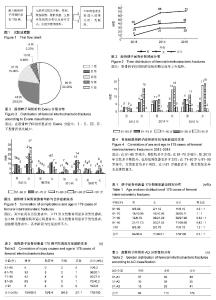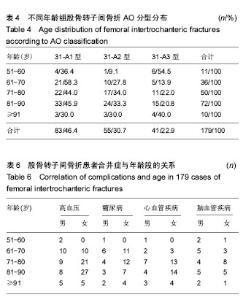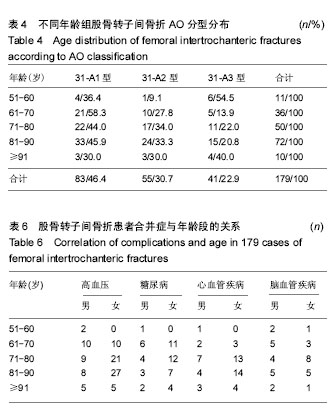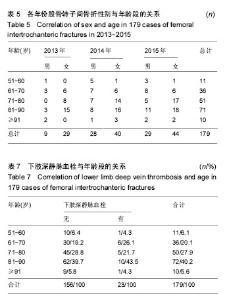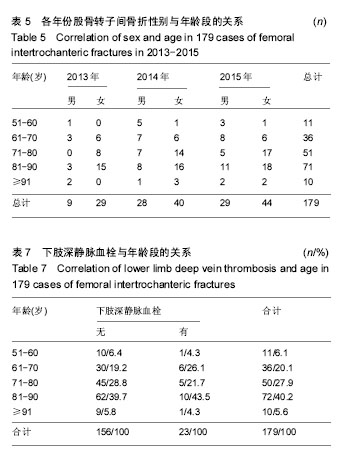| [1] 张向敏. 高龄股骨粗隆部骨折患者的手术治疗[J]. 医学信息,2014, 30(27):688-689.[2] 宣华兵,吴显培,白波,等. 高龄患者股骨粗隆间骨折内固定治疗选择[J]. 广州医学院学报,2005,33(2):36-39.[3] 唐海,罗先正. 1043例髋部骨折的病因分析[J]. 中华骨科杂志,1996, 16(12):763-765.[4] Sakamoto K, Nakamura T, Hagino H, et al. Report on the Japanese Orthopaedic Association’s 3-year project observing hip fractures at fixed-point hospitals. J Orthop Sci. 2006;11(2):127-134.[5] 许新忠, 荆珏华. 股骨转子间骨折治疗进展[J]. 中国伤残医学,2014, 22(17):216-218.[6] 吴浩波,李杭,郑强,等. 经皮加压钢板和短重建钉治疗股骨转子间骨折的对照研究[J]. 中华骨科杂志,2010,30(9):865-869.[7] 郑松柏,尹英民,林伟龙,等. 髋部骨折1266例流行病学调查分析[J]. 老年医学与保健,2013,19(3):161-164.[8] Löfman O, Berglund K, Larsson L, et al. Changes in Hip Fracture Epidemiology: Redistribution Between Ages, Genders and Fracture Types. Osteoporos Int. 2002;13(1):18-25.[9] Hernández JL, Olmos JM, Alonso MA, et al. Trend in hip fracture epidemiology over a 14-year period in a Spanish population. Osteoporos Int. 2006;17(3):464-470.[10] 孙志颖,吴云峰. 北京东高地地区859例体检人群的骨密度情况分析[J]. 现代中西医结合杂志,2010,19(22):2759-2760.[11] 尤春芳,须惠玉,刘哲军. 引起老年人髋部骨折跌倒的研究进展[J]. 解放军护理杂志,2010,27(5):352-355.[12] 王影,傅秀珍,张广清. 老年髋部骨折患者跌倒风险及自我效能的评估[J]. 广东医学,2013,34(7):1141-1143.[13] Suzuki T, Kim H, Yoshida H, et al. Randomized controlled trial of exercise intervention for the prevention of falls in community-dwelling elderly Japanese women. J Bone Miner Metab. 2004;22(6):602-611.[14] 黄晓文,张健,蒋协远. 1139例老年髋部骨折治疗及流行病学分析[J]. 中国医刊,2016,51(6):91-94.[15] 庞再力. 老年股骨转子间骨折的临床分型及治疗进展[J]. 黑龙江医学, 2013,23(8):781-784.[16] Suzuki T, Kim H, Yoshida H, et al. Randomized controlled trial of exercise intervention for the prevention of falls in community-dwelling elderly Japanese women. J Bone Miner Metab. 2004;22(6):602-611.[17] 贺彩霞,曲美岩,贺永萍. 延续护理对老年髋部骨折患者术后功能恢复的影响[J]. 中国医刊,2014,49(8):103-104.[18] 王桢,赵兴山,孙华毅. 老年髋部骨折围术期心功能不全患者E/e’的应用研究[J]. 中国医刊,2015,50(12):27-29.[19] 林华. 骨质疏松髋部骨折与生活方式管理[J]. 中国临床医生杂志,2013, 41(6):9-11.[20] 李永,胡振忠,李东超,等. 老年髋部骨折手术治疗与非手术治疗患者的耐受性分析及手术影响因素探讨[J]. 中国临床医生杂志,2015,43(12):66-69.[21] 胡承方,张长青,柴益民,等. 设立专科病房治疗老年髋部骨折的初步经验[J]. 中华创伤骨科杂志,2015,17(2):97-103.[22] Chen H, Ho C, Li C. Increased risks of hip fracture in diabetic patients of Taiwan: a population-based study. Diabetes Care. 2008;31(1):75-80.[23] Dede A D, Tournis S, Dontas I, et al. Type 2 diabetes mellitus and fracture risk. Metabolism. 2014;63(12):1480-1490.[24] Strotmeyer ES, Kamineni A, Cauley JA, et al. Potential Explanatory Factors for Higher Incident Hip Fracture Risk in Older Diabetic Adults. Curr Gerontol Geriatr Res. 2011;2011:979270. [25] Hothersall EJ, Livingstone SJ, Looker HC, et al. Contemporary Risk of Hip Fracture in Type 1 and Type 2 Diabetes: A National Registry Study From Scotland. J Bone Miner Res. 2014;29(5):1054-1060.[26] 张成,王红涛,贾兆松. 老年创伤股骨粗隆间骨折并发DVT的危险因素分析[J]. 医疗装备,2016,29(2):152-153.[27] 许玉慈,王静,罗亚云. 老年髋部骨折术后并发深静脉血栓形成的预防及护理[J]. 现代医药卫生,2013,29(23):3631-3633. |
